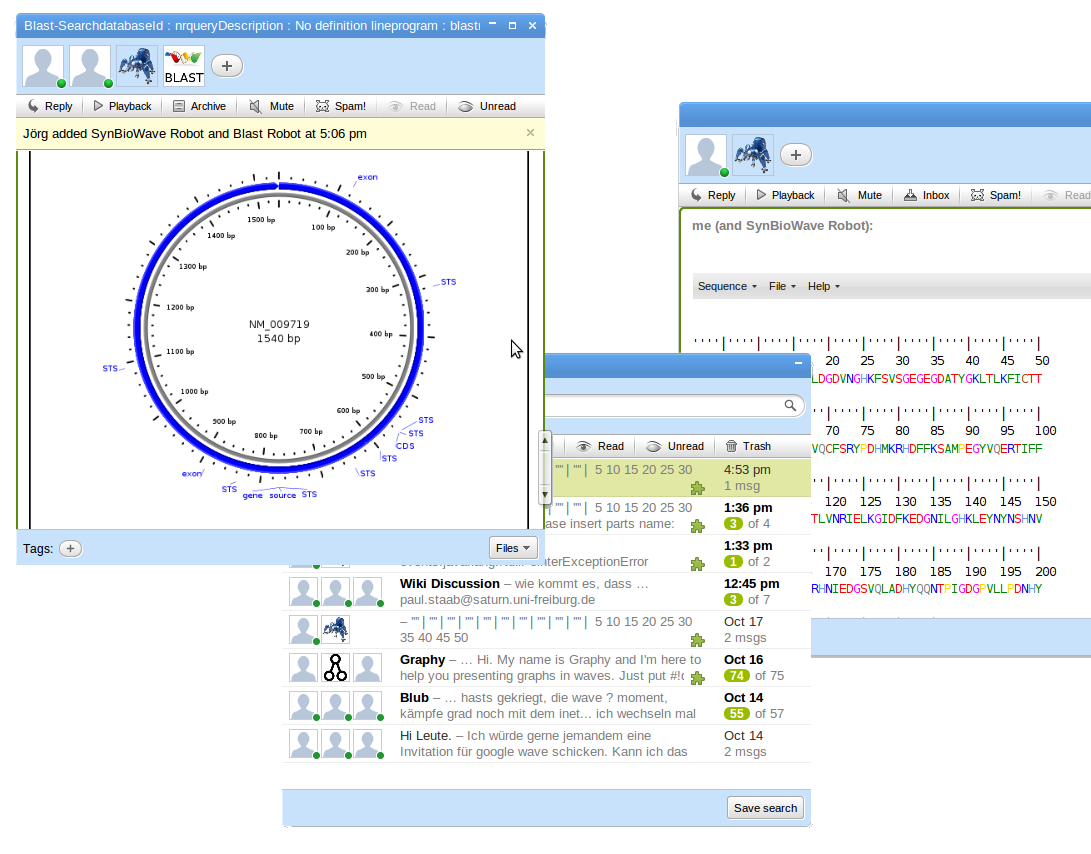Team:Freiburg software
From 2009.igem.org
(→Project Summary) |
|||
| Line 11: | Line 11: | ||
=Project Summary= | =Project Summary= | ||
| + | |||
| + | |||
| + | |||
==SynBioWave== | ==SynBioWave== | ||
| Line 17: | Line 20: | ||
Synthetic Biology aims at constructing whole new genomes. Such an effort is pushed forward by many users and relies on modular combination of genetic elements. The genetic elements represent an increasing complexity by assembling parts to devices and then systems. The construction process needs to be transparent and even at final stages control at the basepair level is required. We propose to build a user environment able to analyze and construct genetic parts and ultimately genomes. | Synthetic Biology aims at constructing whole new genomes. Such an effort is pushed forward by many users and relies on modular combination of genetic elements. The genetic elements represent an increasing complexity by assembling parts to devices and then systems. The construction process needs to be transparent and even at final stages control at the basepair level is required. We propose to build a user environment able to analyze and construct genetic parts and ultimately genomes. | ||
| - | + | Our concept is to create a collaborative web application called SynBioWave for synthetic biology purpose. Based on Google Wave and extended with molecular biology tools from the BioJava library, SynBioWave gives synthetic biological research access to the collaborative and interactive web 2.0. | |
| + | |||
| + | SynBioWave makes use of Wave's powerful communication and collaboration functionality and is designed to be be easily extended with new synthetic biology functionality. Mashing up the reinvention of the email with a major library for processing synthetic biology data, raises science collaboration to a new level. | ||
| + | |||
| + | Our small team of three developers is not be able to create a feature complete software by iGEM Jamboree 2009. Our goal is to lay the foundation for a robust software suite and to implement some basic synthetic biological functionality to demonstrate the the principle use, with some molecular biology standard tasks, as well as the power of the wave approach for a distributed collaborative synthetic biology effort. | ||
The first developments of 'SynBioWave' will lay the ground for a useful grouping of functionality for wave-robots, how the calling of robots and their functions is managed, how robots act on DNA or protein sequences, how intermediate results are stored, etc... The process should be open and clear so that users can add and share robots useful for synthetic biology. | The first developments of 'SynBioWave' will lay the ground for a useful grouping of functionality for wave-robots, how the calling of robots and their functions is managed, how robots act on DNA or protein sequences, how intermediate results are stored, etc... The process should be open and clear so that users can add and share robots useful for synthetic biology. | ||
Revision as of 18:37, 18 October 2009
Project Summary
SynBioWave
Synthetic Biology aims at constructing whole new genomes. Such an effort is pushed forward by many users and relies on modular combination of genetic elements. The genetic elements represent an increasing complexity by assembling parts to devices and then systems. The construction process needs to be transparent and even at final stages control at the basepair level is required. We propose to build a user environment able to analyze and construct genetic parts and ultimately genomes.
Our concept is to create a collaborative web application called SynBioWave for synthetic biology purpose. Based on Google Wave and extended with molecular biology tools from the BioJava library, SynBioWave gives synthetic biological research access to the collaborative and interactive web 2.0.
SynBioWave makes use of Wave's powerful communication and collaboration functionality and is designed to be be easily extended with new synthetic biology functionality. Mashing up the reinvention of the email with a major library for processing synthetic biology data, raises science collaboration to a new level.
Our small team of three developers is not be able to create a feature complete software by iGEM Jamboree 2009. Our goal is to lay the foundation for a robust software suite and to implement some basic synthetic biological functionality to demonstrate the the principle use, with some molecular biology standard tasks, as well as the power of the wave approach for a distributed collaborative synthetic biology effort.
The first developments of 'SynBioWave' will lay the ground for a useful grouping of functionality for wave-robots, how the calling of robots and their functions is managed, how robots act on DNA or protein sequences, how intermediate results are stored, etc... The process should be open and clear so that users can add and share robots useful for synthetic biology.
 "
"
